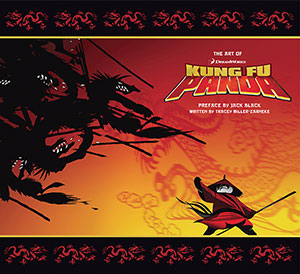
The Art of Kung Fu Panda by Tracey Miller-Zarnecke, with a foreword by Jack Black, draws readers into the world of the DreamWorks Animation movie that was nominated for an Academy Award in the category of Animated Feature Film and kicked cartoon butt at the Annie Awards, defeating presumed front-runner WALL-E to become the surprise Chosen One of the evening.
Kung Fu Panda pulled out all its martial arts moves Friday night at the 36th annual Annie Awards, where it was named best animated feature.
Winning the top prize over such other nominees as the critical favorites WALL-E and Waltz with Bashir, Panda swept the feature film categories as it picked up 10 trophies, bettering Pixar’s Ratatouille run last year when it earned nine Annies, including best feature.
If there was an honour awarded for film tie-ins, then Kung Fu Panda would surely get the nod for The Art of Kung Fu Panda, as well.
Unlike many movie art books, which rarely warrant more than a single once-over, The Art of Kung Fu Panda is a treasure that begs to be admired over and over again. The dustjacket, a thick paper sleeve whose red, yellow, and black cover art reflects the traditional Chinese colour palette, glimmers with red foil dragons that undulate along the top and bottom margins. Hidden underneath, the red hardcover is covered in a delicate wave pattern and embossed with a large, glossy black dragon. Stunning gatefold pages are tucked at random intervals throughout the book, and even the endpapers are works of art, richly patterned with red and golden-yellow dragons and flowers in a style that emulates Chinese silk. A sealed envelope attached to the back endpaper, mysteriously marked “Prepare for Awesomeness”, contains the bonus gift of a small, folded replica of Kung Fu Panda’s film poster.
As an official companion book, The Art of Kung Fu Panda takes adventurous readers behind the scenes of the legendary movie with a team of master filmmakers as their guide. It traces the journey of the production from its first stages of development through to completed animation, accompanied by the candid, insider commentary that’s come to be expected from an “art of” book. Since Kung Fu Panda’s stylized look is so important to the film, the book spends considerable time covering its visual development, especially the use of colour and groundbreaking CG effects. The digitally rendered artwork is so polished and highly detailed that each piece of art, even the roughest of character sketches and conceptual designs, looks like a completed illustration from a children’s picture book. Character designs are thoroughly documented, with every nuance — name origins, clothing styles, related symbols, animal-associated mannerisms, choice of voice actors — explained, lending the animal heroes richer personalities and back-stories. The most interesting revelations in The Art of Kung Fu Panda, though, involve the changes that occurred during the film’s story development. Multiple screenplay and storyboard revisions are explored, showing what might have happened on the paths untaken, and thoughtful reasons are given for the choices which ultimately resulted in the version of Kung Fu Panda that made it to theatre screens.
Order now at Amazon.com:
The Art of Kung Fu Panda
The Art of Kung Fu Panda is distributed by Insight Editions, an imprint of Palace Press International.